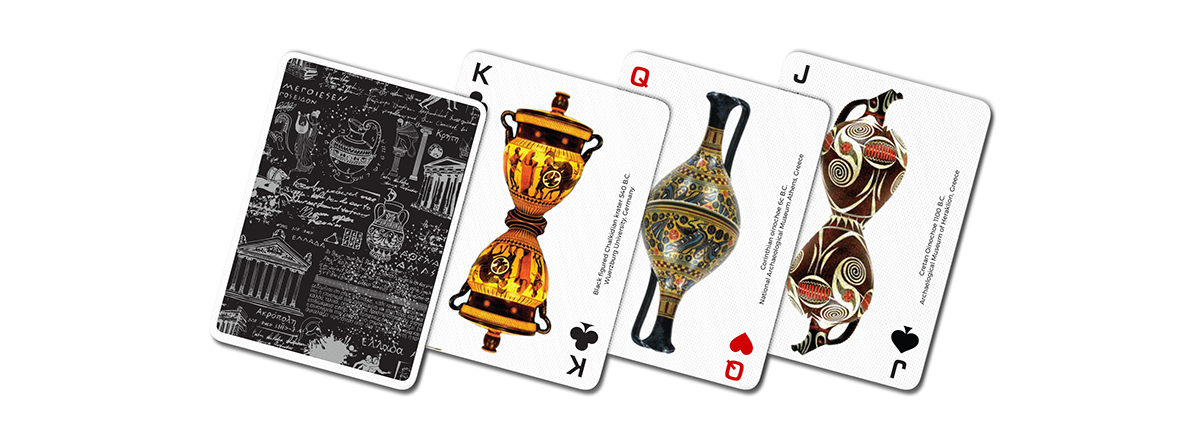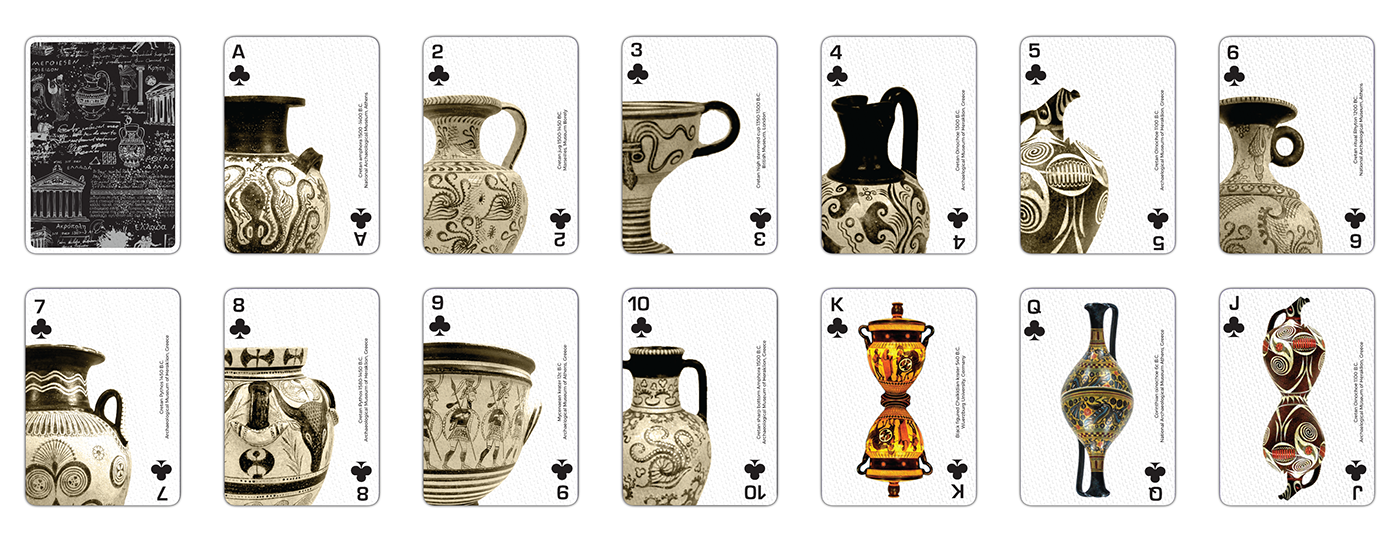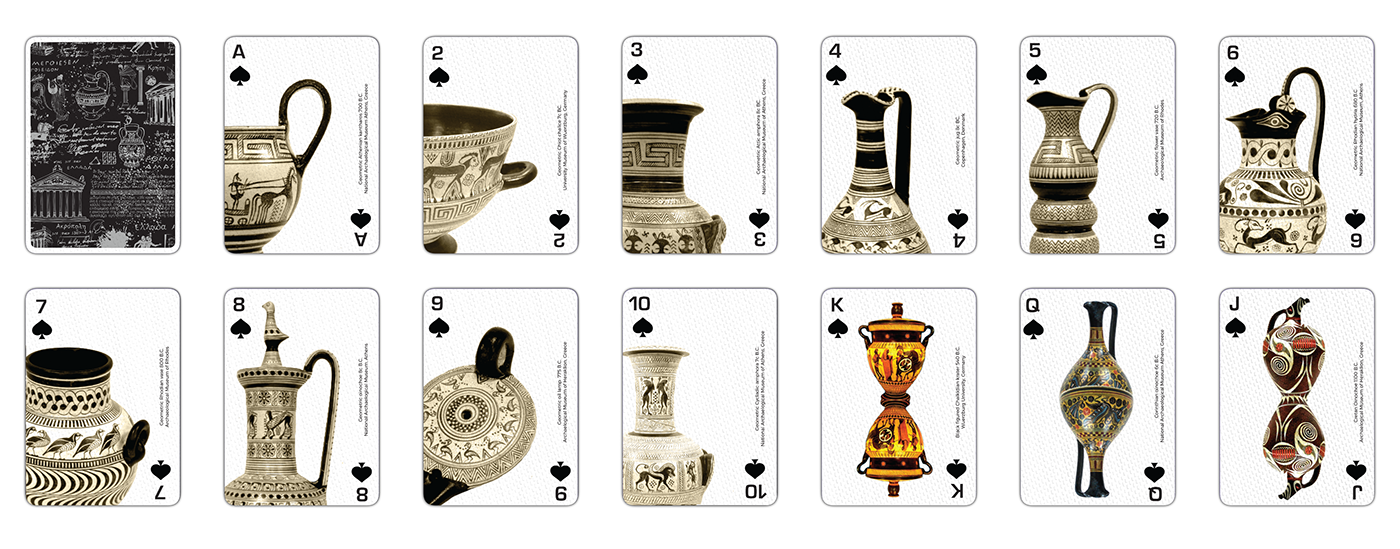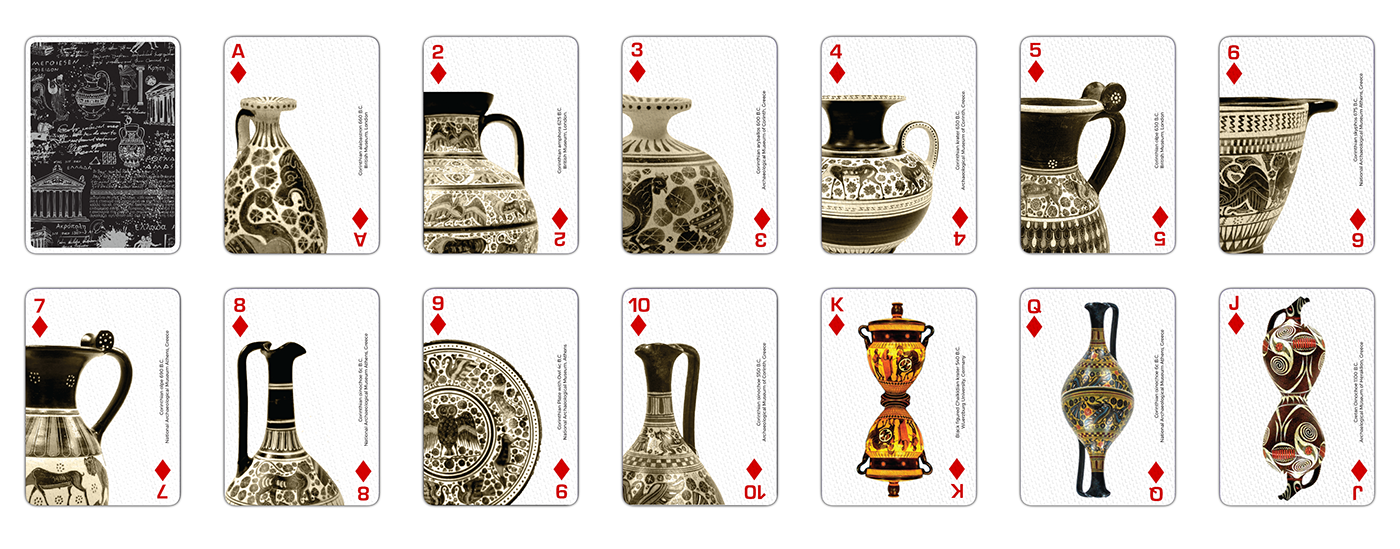
ANCIENT GREEK POTTERY
PLAYING CARDS
PLAYING CARDS

Ancient Greek pottery playing cards concept was created with in mind to educate people about Ancient Greek history.
A huge part of Ancient Greece Art was pottery making. With this project i wanted to create a deck of cards that the player will be able to play but also educate himself about the 40 unique potteries that are on the playing cards.
Also it is important to say that each playing card suit belongs to a different style of pottery such as
Minoan, Geometric, Black Figured and Corinthian
Minoan, Geometric, Black Figured and Corinthian
"On each card the player can find information such as
what date the pottery belongs to and in which museum is today."
what date the pottery belongs to and in which museum is today."






♣
Clubs
Minoan Pottery
The very first flowering of civilization in Greek lands took place in Crete, an island lying to the south east of the Greek mainland. The civilizations of the island of Crete made some truly remarkable contributions to both Greek and Western European civilizations. From the years 2600 BC to 1500 BC, the island of Crete was the center of a wondrous civilization. "Minoan" (after the legendary King Minos) was the name given to the Cretan culture during the Copper and Bronze Age. The creating and building of pots is an art form first developed in Neolithic times. The need for pots arose when the food gathering peoples became food producing peoples. The cultivation of cereal crops meant that the produce had to be stored for future use, in
baskets or pots. The Minoans were one such society whose knowledge of simple pottery blossomed into magnificent art forms.
baskets or pots. The Minoans were one such society whose knowledge of simple pottery blossomed into magnificent art forms.

♥
Hearts
Black Figured Pottery
Although first produced in Corinth, it would be the potters and painters of Attica who would excel above all others in the black-figure style between the 7th and 5th century BC. In this style, the figures were painted black on the reddish orange surface of the vases. Details within the silhouetted figures were incised before firing. Not all figures were painted black as certain colour conventions were adopted, such as white for female flesh and purple-red for clothes and accessories. A greater interest in fine details such as muscles and hair, which were added to the figures using a sharp instrument, is characteristic of the style.However, it is the postures of the figures which also mark out black-figure pottery as the zenith of Greek vase painting. The finest figures are given grace and poise and often illustrated in the moments before actual movement or resting after exertion. The stories were drawn by myths, the Trojan war, the adventures of Odysseus, the Argonauts and other great heroes of the Greek Mythology. Very popular were also the capering satyrs and maenads in the retinue of god Dionysus. Black-figure vases are one of the most important sources of mythology and iconography,
and sometimes also for researching day-to-day ancient Greek life.
and sometimes also for researching day-to-day ancient Greek life.

♠
Spades
Geometric Pottery
The Geometric style appeared from 900 BC and favoured the rectangular space on the main body of the vase between the handles. Bold linear designs (perhaps influenced by contemporary basketwork and weaving styles) appeared in this space with vertical line decoration on either side. It was in this period that the Meander design first appeared (perhaps inspired by the practice of wrapping leaves around the rims of metal bowls), destined to become forever associated with Greece. The lower portion of Geometric vessels were often painted in black and separated from the rest of the vase using horizontal lines. The Geometric style was characterized by deep symbolism. Bodies and limbs were represented by triangles. Thousand of brush strokes were applied to cover the entire surface of the vase with figures, rosettes, meanders, cross hatching and spirals.
The design was arranged in horizontal bands. Paintings on the natural ceramic colour with a lustrous brown glaze, as had been the case with the Minoan vases, created the decoration. Statuettes of birds or horses or miniature vases were often used for handles to the lids.Towards the end of the period, in the 7th century BCE, the so-called Orientalizing style became popular in Corinth. With its eastern trade connections, the city appropriated the stylised plants (e.g. lotus, palm, and the tree of life), animal friezes (e.g. lions), and curved lines of Egyptian and Assyrian pottery to produce its own unique Greek version.

♦
Diamonds
Corinthian Pottery
Corinthian Pottery
In the late 8th century, when the Geometric style was coming to an end, Corinthian contact with the Near East was a stimulus for the Orientalizing style of Greek pottery. The traditionally angular geometric patterns were being replaced with the curvaceous flora and fauna that typify the Protocorinthian style. For much of the 7th and 6th centuries Corinth led the Greek world in producing and exporting pottery. The stylized geometric lines gave way to animal and human figures with rounded contours and considerable animation. Figures such as those that might have been found on Eastern rugs and textiles were dominant in a rhythmic design of floral patterns, dots and rosettes filling the entire background. The Corinthian style was also characterized by an expanded vocabulary of motifs: sphinx, griffin, lions, etc., as well as a repertory of non-mythological animals arranged in friezes across the belly of the vase. In these friezes, painters also began to apply lotuses or palmettes.
Depictions of humans were relatively rare.
Depictions of humans were relatively rare.

PLAY RESPONSIBLY
The safe way to double your money is to fold it over once and put it in your pocket. – Kin Hubbard
AS SEEN



